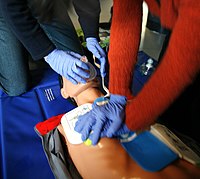
Photo from wikipedia
Non-pharmaceutical intervention such as wearing a mask during the pandemic of SARS-CoV-2 is one of the most important ways to prevent the spread of the virus. However, despite high effectiveness… Click to show full abstract
Non-pharmaceutical intervention such as wearing a mask during the pandemic of SARS-CoV-2 is one of the most important ways to prevent the spread of the virus. However, despite high effectiveness and easy to access, the biggest problem is ‘discomfort’. The purpose of this study was to measure the changes of cardiopulmonary response and related factors affecting breathing discomfort when wearing a mask during vigorous exercise. Fifteen healthy male adults participated in this study. The experimental protocol consisted of three conditions: no mask; KF-94 mask; and sports mask. Each condition consisted of three stages: stage I, 2 m/s on even level; stage II, 2 m/s with 5° inclination; and stage III, 3 m/s on even level. Oxygen saturation (SaO2) and heart rate (HR), partial pressure of carbon dioxide (pCO2), energy expenditure index (EEI), in-mask temperature, humidity, and a five-point scale questionnaire to evaluate subjective discomfort were measured. The results show that there was a significantly higher discomfort score in mask conditions compared with no mask (p < 0.05) and only pCO2 change significantly related to subjective discomfort during exercise (p < 0.05). Moreover, the pCO2 washout was significantly disturbed when wearing a sports mask in stages 2 and 3, which was related to wearer subjective discomfort
Journal Title: International Journal of Environmental Research and Public Health
Year Published: 2022
Link to full text (if available)
Share on Social Media: Sign Up to like & get
recommendations!